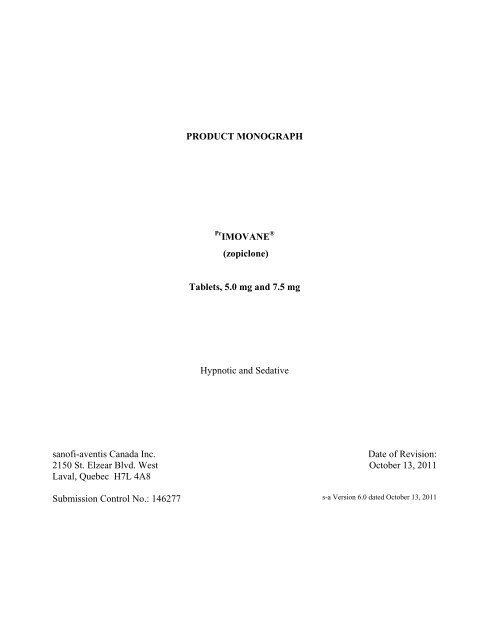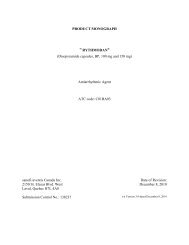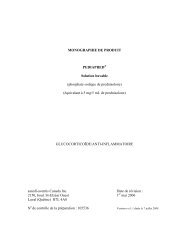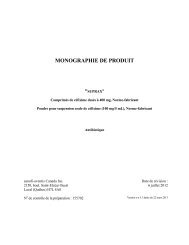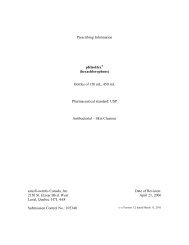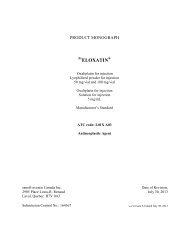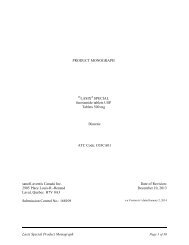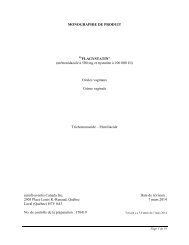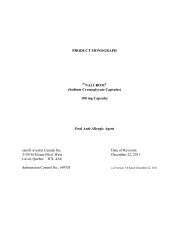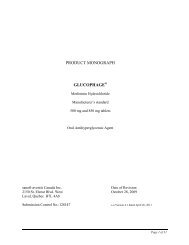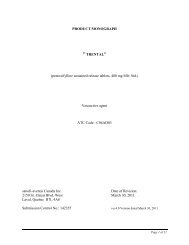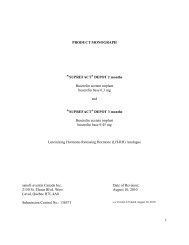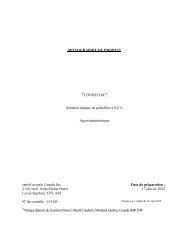Imovane (zopiclone) - Sanofi Canada
Imovane (zopiclone) - Sanofi Canada
Imovane (zopiclone) - Sanofi Canada
You also want an ePaper? Increase the reach of your titles
YUMPU automatically turns print PDFs into web optimized ePapers that Google loves.
sanofi-aventis <strong>Canada</strong> Inc.<br />
2150 St. Elzear Blvd. West<br />
Laval, Quebec H7L 4A8<br />
Submission Control No.: 146277<br />
PRODUCT MONOGRAPH<br />
Pr IMOVANE ®<br />
(<strong>zopiclone</strong>)<br />
Tablets, 5.0 mg and 7.5 mg<br />
Hypnotic and Sedative<br />
Date of Revision:<br />
October 13, 2011<br />
s-a Version 6.0 dated October 13, 2011
NAME OF DRUG<br />
Pr IMOVANE ®<br />
(<strong>zopiclone</strong>)<br />
Tablets, 5.0 mg and 7.5 mg<br />
Hypnotic and Sedative<br />
ACTIONS, CLINICAL PHARMACOLOGY<br />
IMOVANE (<strong>zopiclone</strong>), a cyclopyrrolone derivative, is a short-acting hypnotic agent. IMOVANE<br />
is structurally unrelated to existing hypnotics. However, the pharmacological profile of<br />
IMOVANE is similar to that of the benzodiazepines.<br />
IMOVANE pharmacological properties are: hypnotic, sedative, anxiolytic, anti-convulsant,<br />
muscle-relaxant. These effects are related to a specific agonist action at central receptors<br />
belonging to the GABAa macromolecular complex, modulating the opening of the chloride ion<br />
channel.<br />
In sleep laboratory studies of one to 21-day duration in man, <strong>zopiclone</strong> reduced sleep latency,<br />
increased the duration of sleep and decreased the number of nocturnal awakenings. Zopiclone<br />
delayed the onset of REM sleep but did not reduce consistently the total duration of REM periods.<br />
The duration of stage 1 sleep was shortened, and the time spent in stage 2 sleep increased. In most<br />
studies, stage 3 and 4 sleep tended to be increased, but no change and actual decreases have also<br />
been observed. The effect of <strong>zopiclone</strong> on stage 3 and 4 sleep differs from that of the<br />
benzodiazepines, which suppress slow wave sleep. The clinical significance of this finding is not<br />
known.<br />
With hypnotic drugs, the duration of hypnotic effect and the profile of unwanted effects may be<br />
influenced by the alpha (distribution) (t½α) and beta (elimination) (t½β) half-lives of the<br />
administered drug and any active metabolites formed. When half-lives are long, the drug or<br />
metabolite may accumulate during periods of nightly administration and be associated with<br />
impairments of cognitive and motor performance during waking hours. If half-lives are short, the<br />
drug and metabolites will be cleared before the next dose is ingested, and carry-over effects related<br />
to sedation or CNS depression should be minimal or absent. If the drug has a very short<br />
elimination half-life, it is possible that a relative deficiency (i.e., in relation to the receptor site)<br />
may occur at some point in the interval between each night’s use. This sequence of events may<br />
account for two clinical findings reported to occur after several weeks of nightly use of rapidly<br />
eliminated benzodiazepines or benzodiazepine-like hypnotics: 1) increased wakefulness during the<br />
last third of the night and 2) the appearance of increased day-time anxiety (see WARNINGS).<br />
During nightly use and for an extended period, pharmacodynamic tolerance or adaptation to some<br />
effects of benzodiazepines or benzodiazepine-like hypnotics may develop. However in two sleep<br />
laboratory studies involving 17 patients, there was an absence of tolerance with <strong>zopiclone</strong> for<br />
treatment periods of more than 4 weeks.<br />
2
Rebound insomnia:<br />
Some manifestations of rebound insomnia have been reported both in sleep laboratory and clinical<br />
studies following the withdrawal of <strong>zopiclone</strong> (see PRECAUTIONS).<br />
Zopiclone treatment was associated with dose-related residual effects (see PRECAUTIONS).<br />
Pharmacokinetics<br />
Absorption:<br />
Zopiclone is rapidly and well absorbed. Bioavailability is more than 75%, indicating the absence<br />
of a significant first-pass effect. After the administration of 3.75 and 7.5 mg doses, peak plasma<br />
concentrations of 30 and 60 ng/mL, respectively were reached in less than 2 hours. Absorption<br />
was similar in males and females.<br />
Repeated daily administration of a 7.5 mg oral dose for 14 days did not change the<br />
pharmacokinetic characteristics of <strong>zopiclone</strong> and did not lead to accumulation.<br />
Distribution:<br />
Zopiclone is rapidly distributed from the vascular compartment (distribution half-life [t½α]:<br />
1.2 hours) while the elimination half-life is approximately 5 hours (range: 3.8 to 6.5 hours).<br />
Plasma protein binding is low (approximately 45% in the 25-100 ng/mL concentration range) and<br />
non saturable. The risk of drug interaction arising from displacement of bound drug is low. The<br />
distribution volume is 91.8-104.6 liters.<br />
Metabolism:<br />
Zopiclone is extensively metabolized by three major pathways; only about 4 to 5% of the drug is<br />
excreted unchanged in the urine.<br />
An in vitro study indicates that cytochrome P450 (CYP) 3A4 is the major isoenzyme involved in<br />
the metabolism of <strong>zopiclone</strong> to both metabolites, and that CYP2C8 is also involved with Ndesmethyl<br />
<strong>zopiclone</strong> formation.<br />
The principal metabolites are the N-oxide derivative (~12%), which has weak pharmacological<br />
activity in animals, and the N-desmethyl metabolite (~16%), which is pharmacologically inactive.<br />
Their apparent half-lives evaluated from the urinary data are approximately 4.5 and 7.4 hours,<br />
respectively. Both metabolites are excreted renally.<br />
Other metabolites resulting from oxidative decarboxylation are partly eliminated via the lung as<br />
carbon dioxide. In animals, <strong>zopiclone</strong> did not induce hepatic microsomal enzymes.<br />
3
Excretion:<br />
Excretion studies, using C 14 -<strong>zopiclone</strong> have shown that more than 90% of the administered dose<br />
was excreted over a period of 5 days, 75% being eliminated in the urine and 16% in the feces.<br />
The low renal clearance of unchanged <strong>zopiclone</strong> (mean 8.4 mL/min) compared with that of plasma<br />
(232 mL/min) indicates that <strong>zopiclone</strong> clearance is mainly metabolic.<br />
Special patient population:<br />
Elderly subjects: the absolute bioavailability of <strong>zopiclone</strong> was increased (94% vs 77% in young<br />
subjects) and the elimination half-life prolonged (~7 hours). Accumulation has not been observed<br />
on repeated dosing.<br />
Patients with hepatic insufficiency: elimination half-life was substantially prolonged (11.9 hours)<br />
and time to peak plasma levels delayed (3.5 hours). Consequently, lower doses are recommended<br />
(see DOSAGE AND ADMINISTRATION).<br />
In cirrhotic patients, the plasma clearance of IMOVANE is reduced by approximately 40% in<br />
relation with the decrease of the demethylation process. Therefore, dosage will have to be<br />
modified in these patients.<br />
Patients with mild to moderate renal insufficiency: the pharmacokinetics of <strong>zopiclone</strong> were not<br />
affected. In renal insufficiency, no accumulation of <strong>zopiclone</strong> or of its metabolites has been<br />
detected after prolonged administration.<br />
IMOVANE is removed by hemodialysis; however, hemodialysis is of no value in treating<br />
overdose due to the large volume of distribution of IMOVANE (see also SYMPTOMS AND<br />
TREATMENT OF OVERDOSAGE). Hemodialysis did not appear to increase the plasma<br />
clearance of the drug.<br />
Lactating women: <strong>zopiclone</strong> was present in the milk, its concentration paralleled plasma levels but<br />
was about 50% lower (see PRECAUTIONS, Use in nursing mothers).<br />
INDICATIONS AND CLINICAL USE<br />
Sleep disturbance may be the presenting manifestation of a physical and/or psychiatric disorder.<br />
Consequently, a decision to initiate symptomatic treatment of insomnia should only be made after<br />
the patient has been carefully evaluated.<br />
IMOVANE (<strong>zopiclone</strong>) is indicated for the short-term treatment and symptomatic relief of<br />
insomnia characterized by difficulty in falling asleep, frequent nocturnal awakenings and/or early<br />
morning awakenings.<br />
Treatment with IMOVANE should usually not exceed 7-10 consecutive days. Use for more than<br />
4
2-3 consecutive weeks requires complete re-evaluation of the patient. Prescriptions for IMOVANE<br />
should be written for short-term use (7-10 days) and it should not be prescribed in quantities<br />
exceeding a 1-month supply.<br />
The use of hypnotics should be restricted for insomnia where disturbed sleep results in impaired<br />
daytime functioning.<br />
CONTRAINDICATIONS<br />
IMOVANE is contraindicated in patients with known hypersensitivity to the drug or any<br />
component or its formulation, in patients with myasthenia gravis and severe hepatic insufficiency<br />
and in those with severe impairment of respiratory function, e.g., significant sleep apnea<br />
syndrome.<br />
General:<br />
WARNINGS<br />
Benzodiazepine and benzodiazepine-like compounds should be used with extreme caution in<br />
patients with a history of substance or alcohol abuse.<br />
Because some of the adverse effects of IMOVANE may be dose related, the smallest possible<br />
effective dose should be prescribed, especially for elderly patients. Inappropriate, heavy sedation<br />
in the elderly, may result in accidental events/falls.<br />
The cause of insomnia should be identified wherever possible and the underlying factors treated<br />
before a hypnotic is prescribed. The failure of insomnia to remit after 7-10 days of treatment may<br />
indicate the presence of a primary psychiatric and/or medical illness or the presence of sleep state<br />
misperception.<br />
Worsening of insomnia or the emergence of new abnormalities of thinking or behaviour may be<br />
the consequence of an unrecognized psychiatric or physical disorder. These have also been<br />
reported to occur in association with the use of drugs that act at the benzodiazepine receptors.<br />
IMOVANE should be used with caution in patients who in the past manifested paradoxical<br />
reactions to alcohol and/or sedative medications.<br />
Lactose is a non-medicinal ingredient in IMOVANE 5 mg. Patients with rare hereditary diseases<br />
of galactose intolerance (galactosemia or glucose-galactose malabsorption) should not take<br />
IMOVANE 5 mg. IMOVANE 7.5 mg does not contain lactose.<br />
Pregnancy:<br />
Benzodiazepines may cause fetal damage when administered during pregnancy. During the first<br />
trimester of pregnancy, several studies have suggested an increased risk of congenital<br />
malformations associated with the use of benzodiazepines.<br />
5
Insufficient data are available on <strong>zopiclone</strong> to assess its safety during human pregnancy. Thus, the<br />
use of IMOVANE during pregnancy is not recommended. If IMOVANE is prescribed to a woman<br />
of child-bearing potential, the patient should be warned of the potential risk to a fetus and advised<br />
to consult her physician regarding the discontinuation of the drug if she intends to become<br />
pregnant or suspects that she is pregnant.<br />
During the last weeks of pregnancy or during labor, ingestion of therapeutic doses of<br />
benzodiazepine hypnotic drugs has resulted in neonatal CNS depression due to transplacental<br />
distribution. Similar effects can be expected to occur with <strong>zopiclone</strong>, due to its pharmacological<br />
effects. If IMOVANE is used during the last three months of pregnancy or during labour, effects<br />
on the neonate, such as hypothermia, hypotonia, and respiratory depression can be expected.<br />
A child born to a mother who took sedative/hypnotics agents chronically during the latter stages of<br />
pregnancy may have developed physical dependence and may be at risk for developing<br />
withdrawal symptoms in the postnatal period.<br />
Amnesia:<br />
Anterograde amnesia of varying severity has been reported following therapeutic doses of<br />
benzodiazepines or benzodiazepine-like agents. The event is rare with IMOVANE. Anterograde<br />
amnesia may occur, especially when sleep is interrupted or when retiring to bed is delayed after<br />
the intake of the tablet. Anterograde amnesia is a dose-related phenomenon and elderly subjects<br />
may be at particular risk.<br />
Cases of transient global amnesia and “traveller’s amnesia” have also been reported in association<br />
with benzodiazepines, the latter in individuals who have taken the drug, often in the middle of the<br />
night, to induce sleep while travelling. Transient global amnesia and traveller’s amnesia are<br />
unpredictable and not necessarily dose-related phenomena.<br />
To reduce the possibility of anterograde amnesia, patients should ensure that they take the tablet<br />
strictly when retiring for the night. Patients should be warned not to take IMOVANE under<br />
circumstances in which a full night’s sleep and clearance of the drug from the body are not<br />
possible before they need again to resume full activity.<br />
Abnormal thinking and behavioural changes:<br />
Abnormal thinking and other behavioural changes have been reported to occur in association with<br />
the use of benzodiazepines and benzodiazepine-like agents including IMOVANE, although rarely<br />
(see ADVERSE REACTIONS). Some of the changes may be characterized by decreased<br />
inhibition, e.g., aggression or extroversion that seems excessive, similar to that seen with alcohol<br />
and other CNS depressants (e.g., sedative/hypnotics). Particular caution is warranted in patients<br />
with a history of violent behaviour and a history of unusual reactions to sedatives including<br />
alcohol and the benzodiazepines or benzodiazepine-like agents. Psychotic behavioural changes<br />
that have been reported include abnormal behaviour, restlessness, agitation, irritability,<br />
hallucinations, delusion, anger, nightmare and depersonalization. Abnormal behaviours associated<br />
6
with the use of benzodiazepines or benzodiazepine-like agents have been reported more with<br />
chronic use and/or high doses but they may occur during the acute, maintenance or withdrawal<br />
phases of treatment.<br />
It can rarely be determined with certainty whether a particular instance of abnormal behaviours<br />
listed above is drug induced, spontaneous in origin, or a result of an underlying psychiatric<br />
disorder. Nevertheless, the emergence of any new behavioural sign or symptom of concern<br />
requires careful and immediate evaluation. Should these occur, use of the product should be<br />
discontinued. These reactions are more likely to occur in the elderly.<br />
Cognitive Function:<br />
The benzodiazepines and benzodiazepine-like agents affect mental efficiency, e.g., concentration,<br />
attention and vigilance. The risk of confusion is greater in the elderly and in patients with cerebral<br />
impairment.<br />
Anxiety, restlessness:<br />
An increase in daytime anxiety and/or restlessness have been observed during treatment with<br />
IMOVANE. This may be a manifestation of interdose withdrawal, due to the short elimination<br />
half-life of the drug.<br />
Depression:<br />
Caution should be exercised if IMOVANE is prescribed to patients with signs and symptoms of<br />
depression that could be intensified by hypnotic drugs. The potential for self-harm (e.g.,<br />
intentional overdose) is high in patients with depression and thus, the least amount of drug that is<br />
feasible should be available to them at any one time.<br />
As with other hypnotics, IMOVANE does not constitute a treatment of depression and may even<br />
mask its symptoms.<br />
Complex sleep-related behaviours:<br />
Complex sleep-related behaviours such as “sleep-driving” (i.e., driving while not fully awake after<br />
ingestion of a sedative-hypnotic, with amnesia for the event) have been reported in patients who<br />
have taken IMOVANE. Other potentially dangerous behaviours have been reported in patients<br />
who got out of bed after taking a sedative-hypnotic and were not fully awake, including preparing<br />
and eating food, making phone calls, leaving the house, etc. As with “sleep-driving”, patients<br />
usually do not remember these events. Although complex sleep-related behaviours may occur with<br />
IMOVANE alone at therapeutic doses, the use of alcohol and other CNS-depressants with<br />
IMOVANE appears to increase the risk of such behaviours, as does the use of IMOVANE at doses<br />
exceeding the maximum recommended dose.<br />
IMOVANE is not to be taken with alcohol.<br />
Caution is needed with concomitant use of other CNS depressants drugs.<br />
7
Caution is recommended in patients with a personal or family history of sleepwalking. Although<br />
complex sleep-related behaviours have been reported in patients with or without history of<br />
sleepwalking, it is possible that some predisposed patients are at increased risk of experiencing<br />
these complex behaviours during treatment with IMOVANE.<br />
The use of IMOVANE in patients with other disorders known to affect sleep and induce frequent<br />
awakenings (e.g. sleep apnea, Periodic Limb Movement Disorder, Restless Legs Syndrome) is<br />
discouraged, as they may be also at increased risk of complex sleep-related behaviours.<br />
Treatment with IMOVANE is limited to a short duration (see INDICATIONS, DOSAGE AND<br />
ADMINISTRATION).<br />
Patients should be instructed not to exceed the recommended dose.<br />
Caution should be exercised with concomitant use of potent CYP3A4 inhibitors (see DRUG<br />
INTERACTIONS).<br />
Due to the risk to the patient and the community, discontinuation of IMOVANE should be<br />
strongly considered for patients who report any such complex sleep-related behaviours.<br />
Severe Anaphylactic and Anaphylactoid Reactions:<br />
Rare cases of angioedema involving the tongue, glottis or larynx have been reported in patients<br />
after taking the first or subsequent doses of sedative-hypnotics, including IMOVANE. Some<br />
patients have had additional symptoms such as dyspnea, throat closing or nausea and vomiting that<br />
suggest anaphylaxis. Some patients have required medical therapy in the emergency department. If<br />
angioedema involves the throat, glottis or larynx, airway obstruction may occur and be fatal.<br />
Patients who develop angioedema after treatment with IMOVANE should not be rechallenged<br />
with the drug.<br />
PRECAUTIONS<br />
Drug abuse, dependence and withdrawal:<br />
Use of sedative/hypnotics agents like IMOVANE may lead to the development of physical and<br />
psychological dependence or abuse. The risk of dependence or abuse is increased with the dose<br />
and duration of treatment, if used with alcohol or other psychotropics, in patients with a history of<br />
alcoholism and/or drug abuse or in patients with marked personality disorders. Interdose daytime<br />
anxiety and rebound anxiety may increase the risk of dependency in IMOVANE treated patients.<br />
Once physical dependence has developed, abrupt termination of treatment will be accompanied by<br />
withdrawal symptoms.<br />
Withdrawal symptoms, similar in character to those noted with barbiturates and alcohol<br />
(convulsions, tremor, abdominal and muscle cramps, vomiting, sweating, dysphoria, perceptual<br />
disturbances and insomnia) have occurred following abrupt discontinuation of benzodiazepines<br />
8
and benzodiazepine-like agents, including IMOVANE. The more severe symptoms are usually<br />
associated with higher dosages and longer usage, although patients given therapeutic dosages for<br />
as few as 1-2 weeks can also have withdrawal symptoms including daytime anxiety between<br />
nightly doses.<br />
Consequently, abrupt discontinuation should be avoided and a gradual dosage tapering schedule is<br />
recommended in any patient taking the drug for more than a few weeks. The recommendation for<br />
tapering is particularly important in patients with a history of seizures (see ADVERSE<br />
REACTIONS).<br />
As with all hypnotics, repeat prescriptions should be limited to those who are under medical<br />
supervision.<br />
It may be useful to inform the patient when treatment is started that it will be of limited duration<br />
and to explain precisely how the dosage will be progressively decreased.<br />
Rebound insomnia<br />
A transient syndrome whereby the symptoms that led to treatment with a benzodiazepine or<br />
benzodiazepine-like agent recur in an enhanced form, may occur on withdrawal of hypnotic<br />
treatment. It may be accompanied by other reactions including mood changes, anxiety and<br />
restlessness.<br />
Since the risk of such phenomena is greater after abrupt discontinuation of IMOVANE, especially<br />
after prolonged treatment, it is, therefore recommended to decrease the dosage gradually and to<br />
advise the patient accordingly (see ADVERSE REACTIONS). It is important that the patient<br />
should be aware of the possibility of rebound phenomena, thereby minimizing anxiety over such<br />
symptoms should they occur while the medicinal product is being discontinued.<br />
Tolerance<br />
Some loss of efficacy of other hypnotics may develop after repeated use. However, there was an<br />
absence of tolerance with IMOVANE for treatment periods of up to 4 weeks.<br />
Patients with specific conditions:<br />
IMOVANE should be given with caution to patients with impaired hepatic or renal function, or<br />
chronic pulmonary insufficiency. Dosage adjustments are recommended (see DOSAGE AND<br />
ADMINISTRATION). Respiratory depression has been reported in patients with compromised<br />
respiratory function.<br />
IMOVANE is contraindicated in patients with myasthenia gravis and severe hepatic insufficiency<br />
and in those with severe impairment of respiratory function, e.g., significant sleep apnea syndrome<br />
(see CONTRAINDICATIONS).<br />
Patients requiring mental alertness / driving:<br />
Because of IMOVANE pharmacological properties and CNS depressant effect, IMOVANE may<br />
adversely affect the ability to drive or use machines. Patients receiving the drug should be<br />
cautioned against engaging in hazardous occupations requiring complete mental alertness such as<br />
operating machinery or driving a motor vehicle. For the same reason, patients should be warned<br />
9
against the concomitant ingestion of IMOVANE and alcohol or CNS depressant drugs (see DRUG<br />
INTERACTIONS).<br />
Use in pregnancy:<br />
The use of IMOVANE during pregnancy is not recommended (see WARNINGS section).<br />
Use in nursing mothers:<br />
IMOVANE is excreted in human milk, and its concentration may reach 50% of the plasma levels.<br />
Insufficient data are available on IMOVANE to assess its safety during lactation. Therefore, the<br />
administration of IMOVANE to nursing mothers is not recommended.<br />
Pediatrics (< 18 years of age):<br />
The safety and effectiveness of IMOVANE in children and young adults below the age of 18 have<br />
not been established.<br />
Geriatrics (≥ 65 years of age):<br />
Elderly patients are especially susceptible to dose-related adverse effects, such as drowsiness,<br />
dizziness, or impaired coordination. Inappropriate, heavy sedation may result in accidental<br />
events/fall. Therefore, the lowest possible dose should be used in these subjects (see DOSAGE<br />
AND ADMINISTRATION, Geriatric patients). Anterograde amnesia is a dose-related<br />
phenomenon and elderly subjects may be at particular risk.<br />
DRUG INTERACTIONS<br />
The risk of drug interaction arising from displacement of bound drug is low.<br />
Alcohol<br />
Concomitant intake with alcohol is not recommended (see WARNINGS, Complex sleep-related<br />
behaviours). IMOVANE may produce additive CNS depressant effects when co-administered with<br />
alcohol.<br />
CNS Depressants<br />
IMOVANE may produce additive CNS depressant effects when co-administered with sedative<br />
antihistamines, anticonvulsants, narcotic analgesics, anesthetics, or psychotropic medications such<br />
as antipsychotics (neuroleptics), hypnotics, anxiolytics/sedatives, and antidepressant agents which<br />
themselves can produce CNS depression. In the case of narcotic analgesics, enhancement of<br />
euphoria may also occur leading to an increase in psychological dependence.<br />
Drugs Affecting Cytochrome P450 Enzymes<br />
Since IMOVANE is metabolized by the cytochrome P450 (CYP) 3A4 isoenzyme (see ACTION<br />
AND CLINICAL PHARMACOLOGY, Pharmacokinetics, Metabolism), plasma levels of<br />
IMOVANE may be increased when co-administered with CYP3A4 inhibitors, such as<br />
erythromycin, clarithromycin, ketoconazole, itraconazole, and ritonavir. A dose reduction for<br />
IMOVANE may be required when it is co-administered with CYP3A4 inhibitors. Conversely,<br />
plasma levels of IMOVANE may be decreased when co-administered with CYP3A4 inducers,<br />
10
such as rifampicin or rifampin, carbamazepine, phenobarbital, phenytoin, and St. John’s wort. A<br />
dose increase for IMOVANE may be required when it is co-administered with CYP3A4 inducers.<br />
The effect of erythromycin on the pharmacokinetics of IMOVANE has been studied in 10 healthy<br />
subjects. The AUC of IMOVANE is increased by 80% in presence of erythromycin. The hypnotic<br />
effect of IMOVANE may be enhanced when administered with erythromycin.<br />
ADVERSE REACTIONS<br />
The most common adverse reaction seen with IMOVANE is taste alteration (bitter taste). Severe<br />
drowsiness and/or impaired coordination are signs of drug intolerance or excessive doses.<br />
The following adverse events were observed in patients receiving IMOVANE. In the absence of<br />
an established cause-effect relationship those adverse reactions that were observed more<br />
frequently with IMOVANE than with a placebo are in italic.<br />
Central Nervous System: Somnolence, dizziness, confusion, anterograde amnesia or memory<br />
impairment, feeling of drunkenness, euphoria, nightmares,<br />
agitation, anxiety or nervousness, hostility, depression, decreased<br />
libido, libido disorder, coordination abnormality, headache,<br />
hypotonia, tremor, muscle spasms, paresthesia, and speech<br />
disorder.<br />
Cardiovascular: palpitations<br />
Hallucinations, aggression, irritability and fall (predominantly in<br />
elderly patients).<br />
Digestive: bitter taste, dry mouth, coated tongue, bad breath, nausea, vomiting,<br />
diarrhea, constipation, anorexia or increased appetite<br />
General Disorders and<br />
Administration Site Conditions: asthenia, chills, fatigue<br />
Respiratory: dyspnea<br />
Special senses: amblyopia<br />
Dermatologic: rash, spots on skin, sweating, pruritus. Rashes and pruritus may<br />
be a sign of drug hypersensitivity; discontinue if this occurs.<br />
Angioedema and/or anaphylactic reactions have been reported<br />
very rarely.<br />
Metabolic and nutritional: weight loss<br />
11
Musculoskeletal: limb heaviness<br />
Laboratory tests: There have been sporadic reports of abnormal laboratory test values. Mild to<br />
moderate increases in serum transaminase and/or blood alkaline phosphatase have been reported<br />
very rarely.<br />
Geriatric patients: Geriatric patients tended to have a higher incidence of palpitations, vomiting,<br />
anorexia, sialorrhea, confusion, agitation, anxiety, tremor and sweating than younger patients.<br />
Anterograde amnesia is a dose-related phenomenon and elderly subjects may be at particular risk.<br />
Withdrawal syndrome has been reported upon discontinuation of IMOVANE (see<br />
PRECAUTIONS, Drug abuse, dependence and withdrawal). Withdrawal symptoms vary and may<br />
include rebound insomnia, muscle pain, anxiety, tremor, sweating, agitation, confusion, headache,<br />
palpitations, tachycardia, delirium, nightmares, irritability. In severe cases the following<br />
symptoms may occur: derealisation, depersonalisation, hyperacusis, numbness and tingling of the<br />
extremities, hypersensitivity to light, noise and physical contact, hallucinations. In very rare cases,<br />
seizures may occur.<br />
Postmarket Experience:<br />
Psychiatric disorders: restlessness, delusion, anger, abnormal behaviours (possibly<br />
associated with amnesia) and somnambulism(see<br />
WARNINGS, Complex sleep-related behaviours),<br />
withdrawal syndrome and dependence have been reported<br />
rarely.<br />
Nervous system disorder: ataxia<br />
Eye disorder: diplopia<br />
Gastrointestional disorders: dyspepsia<br />
Musculoskeletal and<br />
connective tissue disorders: muscular weakness.<br />
SYMPTOMS AND TREATMENT OF OVERDOSAGE<br />
Signs and Symptoms:<br />
Overdose is usually manifested by varying degrees of central nervous system depression ranging<br />
from drowsiness to coma according to the quantity ingested. In mild cases, symptoms include<br />
drowsiness, confusion, and lethargy; in more severe cases, symptoms may include ataxia,<br />
hypotonia, hypotension, methaemoglobinaemia, respiratory depression, and coma. Overdose<br />
should not be life threatening unless combined with other CNS depressants, including alcohol.<br />
12
Other risk factors, such as the presence of concomitant illness and the debilitated state of the<br />
patient, may contribute to the severity of symptoms and very rarely can result in fatal outcome.<br />
In voluntary or accidental cases of IMOVANE overdosage involving doses up to 340 mg, the<br />
principal effects reported were prolonged sleep, drowsiness, lethargy and ataxia.<br />
Recommended Treatment:<br />
Symptomatic and supportive treatment in adequate clinical environment is recommended,<br />
attention should be paid to respiratory and cardiovascular functions. Gastric lavage or activated<br />
charcoal is only useful when performed soon after ingestion.<br />
Hemodialysis is of no value due to the large volume of distribution of IMOVANE. Flumazenil<br />
may be a useful antidote; however, flumazenil administration may contribute to the appearance of<br />
neurological symptoms (agitation, anxiety, convulsions and emotional lability). Intravenous fluids<br />
should be administered as needed.<br />
Poison Control Center:<br />
As with the management of all overdosage, the possibility of multiple drug ingestion should be<br />
considered. The physician may wish to consider contacting a poison control center for up-to-date<br />
information on the management of hypnotic drug product overdosage.<br />
For management of a suspected drug overdose, contact your regional Poison Control Centre.<br />
DOSAGE AND ADMINISTRATION<br />
Treatment with IMOVANE should usually not exceed 7-10 consecutive days. Use for more than<br />
2-3 consecutive weeks requires complete re-evaluation of the patient.<br />
The product should be taken just before retiring for the night.<br />
Adult dose: The usual adult dose is 5.0 mg to 7.5 mg. The 7.5 mg dose should not be exceeded<br />
(see PRECAUTIONS).<br />
Geriatrics (≥ 65 years of age): In the elderly and/or debilitated patient an initial dose of 3.75 mg<br />
(one-half of a 7.5 mg tablet) at bedtime is recommended. The dose may be increased to 5.0 mg or<br />
7.5 mg if the starting dose does not offer adequate therapeutic effect.<br />
Patients with impaired liver function or chronic respiratory insufficiency: The recommended dose<br />
is 3.75 mg (one-half of a 7.5 mg tablet) depending on acceptability and efficacy. Up to 7.5 mg<br />
may be used with caution in appropriate cases.<br />
IMOVANE is contraindicated in patients with severe hepatic insufficiency and in those with<br />
severe impairment of respiratory function, e.g., significant sleep apnea syndrome (see<br />
CONTRAINDICATIONS).<br />
13
Patients with renal insufficiency: Although no accumulation of IMOVANE or of its metabolites<br />
has been detected in cases of renal insufficiency, it is recommended that patients with impaired<br />
renal function should start treatment with 3.75 mg (one-half of a 7.5 mg tablet).<br />
Pediatrics (< 18 years of age)<br />
IMOVANE is not indicated for patients under 18 years of age.<br />
14
(i) Drug substance:<br />
Proper Name: Zopiclone<br />
PHARMACEUTICAL INFORMATION<br />
Chemical Name: (5RS)-6-(5-chloropyridin-2-yl)-7-oxo-6,7-dihydro-5H-pyrrolo[3,4b]pyrazin-5-yl<br />
4-methylpiperazine-1-carboxylate<br />
Structural formula:<br />
Molecular formula: C17H17ClN6O3<br />
Molecular weight: 388.8<br />
Description: A white or slightly yellowish powder, practically insoluble in water,<br />
freely soluble in methylene chloride, sparingly soluble in acetone,<br />
practically insoluble in alcohol. It dissolves in dilute mineral acids.<br />
(ii) Composition:<br />
It melts at about 177 °C, with decomposition.<br />
Zopiclone 7.5 mg: Non-medicinal ingredients core: croscarmellose sodium, calcium<br />
phosphate dihydrate dibasic, magnesium stearate, microcrystalline<br />
cellulose.<br />
Non-medicinal ingredients coating: carnauba wax, FD&C Blue #1,<br />
Opadry II White, polyethylene glycol.<br />
Zopiclone 5.0 mg: Non-medicinal ingredients core: corn starch, dicalcium phosphate,<br />
lactose, magnesium stearate, sodium carboxymethyl starch.<br />
Non-medicinal ingredients coating: hydroxypropyl-methylcellulose,<br />
15
(iii) Storage recommendations:<br />
titanium dioxide<br />
Store in a dry place, at room temperature (15° - 30°C). Protect from light.<br />
Keep in a safe place out of reach of children.<br />
AVAILABILITY OF DOSAGE FORMS<br />
Zopiclone 7.5 mg:<br />
Each oval, scored, blue tablet, marked IMOVANE on one side and the logo rPr on each side of the<br />
score on the other side, contains <strong>zopiclone</strong> 7.5 mg. The 7.5 mg tablet can be broken into two equal<br />
parts of 3.75 mg.<br />
Available in white high-density polyethylene bottles of 100 and 500.<br />
Zopiclone 5.0 mg:<br />
Each round, white tablet, marked IMOVANE 5 on one side and the logo rPr on the other, contains<br />
<strong>zopiclone</strong> 5.0 mg.<br />
Available in white high-density polyethylene bottles of 100.<br />
16
PHARMACOLOGY<br />
Zopiclone, a cyclopyrrolone derivative, is a chemically novel hypnotic agent. However, the<br />
pharmacological and behavioural evaluation of the drug has shown that its effects are similar to<br />
those of the benzodiazepines.<br />
1. CNS Activity<br />
Zopiclone antagonizes chemically and electroshock-induced seizures in mice and rats.<br />
While it potently affects convulsive conditions that involve GABA, it is relatively<br />
ineffective when glycine, another inhibitory amino acid, is involved.<br />
Zopiclone exerts muscle relaxant activity; it inhibits the traction grasping reflex in mice,<br />
reduces the ability of mice and rats to remain on a rotarod and inclined screen,<br />
respectively, relaxes the hind legs of normal cats and blocks polysynaptic reflexes in<br />
chloralosed cats.<br />
Zopiclone also exerts antiaggressive activity; it inhibits footshock-induced fighting<br />
behaviour in mice and septal lesion-induced aggression in rats.<br />
In a “conflict” situation, the drug increases punishment-suppressed lever-pressing<br />
behaviour, which is indicative of anxiolytic activity. Non-punished responding, indicative<br />
of non-specific sedation, is suppressed only at higher doses.<br />
While <strong>zopiclone</strong> does not cause loss of righting reflex in normal mice, it potentiates<br />
narcosis induced by hexobarbital or ethanol.<br />
In a drug discrimination paradigm, where rats are trained to discriminate drug from saline,<br />
the <strong>zopiclone</strong> discriminative stimulus generalized to several benzodiazepines as well as to<br />
pentobarbital. The finding that the benzodiazepines and a barbiturate were able to<br />
substitute for <strong>zopiclone</strong> indicates that <strong>zopiclone</strong> belongs to the same class of drugs.<br />
Tolerance does not develop to the behavioural effects of <strong>zopiclone</strong>, since the<br />
anticonvulsant and taming ED50's are similar in naive and <strong>zopiclone</strong>-treated animals.<br />
2. Receptor binding studies<br />
Zopiclone has a high and specific affinity for benzodiazepine binding sites in several rat<br />
brain regions. The drug can inhibit the binding of 3 H-benzodiazepines, but can itself label<br />
the sites that are recognized both by benzodiazepine agonists and Ro 15-1788, a<br />
benzodiazepine antagonist. Zopiclone does not recognize the peripheral benzodiazepine<br />
receptor sites and lacks affinity for the serotonin, Gaba, α1 and α2 adrenergic, and<br />
dopamine receptors.<br />
The interaction of <strong>zopiclone</strong> with the benzodiazepine receptor/Gaba receptor/chloride<br />
channel complex differs somewhat from that of the benzodiazepines; while it decreases<br />
cGMP concentration in rat cerebellum, its binding is not enhanced either by GABA or by<br />
17
the chloride anion.<br />
3. Dependence Liability<br />
In barbital-dependent rhesus monkeys, <strong>zopiclone</strong> suppressed the abstinence symptoms<br />
which appeared upon withdrawal. Partial and complete suppression was observed at 4 and<br />
16 mg/kg doses, respectively.<br />
Zopiclone, when administered to monkeys at a dose of 16 mg/kg/day for 28 days,<br />
precipitated withdrawal signs of moderate severity. Peak symptoms appeared three and<br />
four days after withdrawal and included hyperirritability, restlesness, tremor, and some<br />
weight loss. The administration of a higher dose for two weeks brought about similar<br />
symptoms upon withdrawal without precipitating convulsions.<br />
Zopiclone was self-administered both intravenously and intragastrically in monkeys. When<br />
the drug was changed to saline, the rate of self-administraton declined rapidly.<br />
4. Cardiovascular and Respiratory Effects<br />
Zopiclone was evaluated in conscious and anesthetized cats, dogs, rabbits and monkeys<br />
with regard to its effect on respiration and several cardiovascular parameters. Most of the<br />
studies involved i.v. administration.<br />
In general, respiration and blood pressure decreased in a dose-dependent fashion while<br />
heart rate and EKG showed little change. Zopiclone affected central respiratory control<br />
mechanisms to a greater extent than the cardiovascular regulatory mechanisms.<br />
5. Drug-Interaction Studies<br />
Zopiclone was evaluated in combination with several drugs and in general interacted either<br />
in an additive or synergistic fashion with diazepam, phenobarbital, trimethadione,<br />
chlorpromazine, hexobarbital, and ethanol. Zopiclone did not modify the effects of<br />
phenytoin, morphine, ketoprofen and gallamine.<br />
The effects of <strong>zopiclone</strong> could be reversed by Ro 15-1788 (flumazenil) a specific<br />
benzodiazepine antagonist.<br />
18
ACUTE TOXICITY<br />
TOXICOLOGY<br />
Studies were carried out in both sexes of several species. The results are summarized in the Table.<br />
SPECIES ROUTE LD50 (mg/kg)<br />
Mice i.v.<br />
i.p.<br />
p.o.<br />
450<br />
580<br />
1150<br />
Rats p.o. 2300<br />
Dogs p.o.<br />
≥ 4500<br />
i.v.<br />
~ 400<br />
Cats p.o. > 1500<br />
Rabbits p.o. ~ 2500<br />
Monkeys p.o. > 4500<br />
Symptoms of toxicity included sedation, CNS depression, ataxia, respiratory depression, and<br />
dyspnea. In dogs, the i.v. administration of <strong>zopiclone</strong> was followed by myoclonic seizures.<br />
LONG-TERM TOXICITY STUDIES<br />
1. Rats (CD Strain)<br />
One-month oral study<br />
Ten rats/sex/dose received <strong>zopiclone</strong> by gavage six days per week at doses of 0, 6, 24 and<br />
120 mg/kg. Dose-related sedation and paresis of hind legs were observed.<br />
Thyroid weights were increased in male rats at all dose levels. In the high dose males, heart<br />
and spleen weights were reduced.<br />
Three-month oral study<br />
Fifteen rats/sex/dose received <strong>zopiclone</strong> by gavage seven days per week at doses of 0, 2,<br />
12 and 120 mg/kg. At the mid and high doses, dose-related hypotonia, adynamia and ptosis<br />
were observed, all of which subsided with time. Weight gain was slightly but significantly<br />
less in mid and high dose male rats than in controls.<br />
At the 120 mg/kg dose the following changes occurred. BSP values decreased in both<br />
sexes; the number of RBC decreased in females; liver weights increased in both males and<br />
females, accompanied by slight changes in the parenchymal liver cells, namely<br />
eosinophilia or basophilia in the portal area.<br />
18-month oral study<br />
Fifty rats/sex/dose received <strong>zopiclone</strong> in the diet at doses of 0, 2, 20 and 200 mg/kg. Of<br />
these animals 15 rats/sex/dose were sacrificed at six months. The lowest dose was well<br />
tolerated.<br />
19
At the high dose the following changes were seen: weight gain was reduced by about 30%<br />
in both sexes; plasma protein levels were elevated at 3 and 6 months in the males and<br />
throughout the study in the females; albumin and globulin levels were elevated; thyroid<br />
weights were increased in male rats, accompanied by thyroid hyperplasia and, in some rats,<br />
by follicular adenomas; liver weights were increased in female rats both at 6 and 18<br />
months; hepatocellular hypertrophy occurred in both sexes.<br />
2. Dogs (Beagle)<br />
One-month oral study<br />
One dog/sex/dose received <strong>zopiclone</strong> six days per week at doses of 0, 6, 24 and 120 mg/kg.<br />
Dose-related sedation and hypotonia of the hind legs were observed. High dose dogs and<br />
the intermediate dose female dog exhibited moderate weight loss.<br />
At the high dose, both dogs had Heinz bodies in circulating erythrocytes and the bone<br />
marrow showed erythroblastic hyperplasia. In addition, the male animal had marked<br />
anemia and active erythropoiesis in the spleen. BUN values were increased at all doses in a<br />
dose-related fashion; liver function tests were somewhat elevated.<br />
Six-month oral study<br />
Six dogs/sex/dose received <strong>zopiclone</strong> seven days per week at doses of 0, 5, 10 and 25<br />
mg/kg. One dog/sex from each group was sacrificed after a 3-month recovery period.<br />
Zopiclone caused slight excitation, ataxia and drowsiness, and drowsiness and sleep at the<br />
5, 10, and 25 mg/kg doses respectively. Late in the study, four dogs had epileptoid seizures<br />
and three of them died. A reduced weight gain was observed only in high dose male dogs.<br />
Platelet counts rose substantially above normal in two high dose female dogs.<br />
Transaminase levels were elevated but not in a dose-dependent manner. Alkaline<br />
phosphatase levels were significantly elevated both in male and female dogs, receiving the<br />
25 mg/kg dose.<br />
While liver weights increased both in male and female dogs in a dose-dependent fashion,<br />
they returned toward control values following the 3-month recovery period. In high dose<br />
male animals, relative spleen, kidney and adrenal weights were significantly increased.<br />
Examination of bone marrow smears showed that the proportion of proerythroblasts and<br />
the ratio of normoblasts to basophilic erythroblasts were significantly greater in high dose<br />
females than in controls.<br />
One-year oral study<br />
Five dogs/sex/dose received <strong>zopiclone</strong> seven days per week at doses of 0, 1, 5 and<br />
25 mg/kg. Zopiclone induced ataxia, sleepiness, lethargy, decreased activity, body tremors<br />
and excitability. The latter two effects occurred prior to dosing, while the others were seen<br />
shortly after dosing. After six months of treatment, <strong>zopiclone</strong> induced epileptoid seizures<br />
in five dogs (four high dose, one mid dose). Since the convulsions were observed early<br />
morning prior to dosing, they might have been a manifestation of withdrawal. Female<br />
20
dogs, treated with 5 mg/kg of <strong>zopiclone</strong>, were significantly heavier than controls. Treated<br />
animals both ate and drank more than did their respective controls.<br />
Platelet counts were elevated in both sexes at the 5 and 25 mg/kg doses. Alkaline<br />
phosphatase was elevated from the first month on in mid and high dose animals. T4 values<br />
in high dose males and BSP values in high dose females were also elevated.<br />
There was a dose-dependent increase in liver weights which became statistically<br />
significant at the 25 mg/kg dose. The elevated liver weights were associated with<br />
histopathological changes, namely vacuolation of hepatocyte cytoplasm with eosinophilic<br />
hyaline bodies.<br />
CARCINOGENICITY<br />
Oncogenicity studies were carried out with <strong>zopiclone</strong> in rats and mice with doses of 1, 10,<br />
100 mg/kg/day for two years. There was an increased incidence of mammary tumours with a shift<br />
toward more anaplastic forms in female and an increase of thyroid tumours in male rats on the<br />
high dose. In the mouse study, females on the high dose had an increased incidence of pulmonary<br />
adenocarcinomas; while males on the high dose had a high number of subcutaneous soft tissue<br />
tumours.<br />
In a wide battery of tests, it was shown that <strong>zopiclone</strong> has no mutagenic or clastogenic<br />
(chromosome-damaging) properties; urine extracts from <strong>zopiclone</strong> treated mice, rats and humans<br />
were similarly not mutagenic.<br />
The effect of <strong>zopiclone</strong> is that of a non-genotoxic oncogen; tumor redistribution phenomena are<br />
frequently observed in rodent carcinogenicity studies, particularly with drugs acting on the central<br />
nervous system and the hormonal balance. The rise of 17 beta-estradiol may be regarded as a<br />
cause for the emergence of mammary tumours and the shift from well differentiated to poorly<br />
differentiated mammary carcinomas. The altered feedback mechanism following accelerated<br />
clearance of T4 and the rise of TSH is responsible for thyroid overstimulation that leads to<br />
formation of thyroid neoplasms. The soft tissue tumours of male mice are brought about by<br />
fighting (a paradoxical reaction) and subsequent initiation by encrustation and foreign body<br />
reaction. The increased incidence of pulmonary adenocarcinomas in female mice may be regarded<br />
as fortuitous (“chance finding”), but there is not enough data available to exclude some other<br />
mechanisms.<br />
No comparable endocrine changes were observed in man given the therapeutic dose of <strong>zopiclone</strong><br />
(7.5 mg). The tumor producing dose of <strong>zopiclone</strong> represents 800 times and the no effect level<br />
80 times the proposed human dose (0.125 mg/kg).<br />
21
MUTAGENICITY<br />
Zopiclone and its metabolic products were tested for mutagenic potential in the following assays:<br />
ASSAY INDICATOR SPECIES<br />
OR ORGANISM<br />
Ames’ test Salmonella typhimurium<br />
(TA98, TA100, TA1535,<br />
TA1537 & TA 1538)<br />
Escherichia coli<br />
(WP2 uvrA)<br />
Ames’ test Salmonella typhimurium<br />
(5 strains as above)<br />
Ames’ test Salmonella typhimurium<br />
(5 strains as above)<br />
Ames’ test Salmonella typhimurium<br />
(5 strains as above)<br />
Escherichia coli<br />
(WP2 uvrA)<br />
DOSES USED<br />
Up to 500 mcg/plate with an without rat<br />
liver microsome activating enzymes.<br />
Concentrated urine extracts from rats<br />
treated at 1, 10 and 100 mg/kg for 20<br />
days.<br />
Up to 5000 mcg/plate with liver<br />
microsomal enzymes from B6C3F1<br />
mice.<br />
1) Urine samples from volunteers<br />
receiving 7.5, 10 or 15 mg with or<br />
without liver microsomal enzymes.<br />
2) Two major metabolites, N-oxide and<br />
N-desmethyl derivatives: up to 1000<br />
mcg/ plate.<br />
In vitro: up to 1000 mcg/mL<br />
In vivo, in mice: 100 mg/kg p.o.<br />
Up to 200 mcg/mL with or without<br />
In vitro and In vivo Saccharomyces cerevisiae<br />
host mediated assay (D7)<br />
Gene forward Chinese Hamster Ovary<br />
mutation test<br />
cells (CHO/HG PRT) metabolic activation.<br />
In vitro mammalian Chinese Hamster Ovary Up to 200 mcg/mL with or without<br />
cell test for<br />
clastogenicity.<br />
cells (CHO/K1 line) metabolic activation.<br />
DNA repair Assay Primary cultures of rat Up to 10<br />
(William’s test) hepatocytes<br />
-4 M.<br />
Dominant lethal test Rats and mice Up to 120 mg/kg/day p.o.<br />
Micronucleus test Mice Up to 630 mg/kg/day p.o.<br />
Sex-linked recessive Drosophila melanogaster 2% solution p.o. activation.<br />
lethal test<br />
cells<br />
(CHO/HG PRT)<br />
All tests were negative. Zopiclone was neither a mutagen nor a clastogen and did not give rise to<br />
mutagenic metabolites either in experimental animals or in man.<br />
22
REPRODUCTION AND TERATOLOGY<br />
1. Fertility and general reproductive performance<br />
The effect of <strong>zopiclone</strong> was evaluated in three studies. First, treated male rats were mated<br />
with treated female rats, the oral doses of <strong>zopiclone</strong> being 0, 2, 12 and 120 mg/kg. The<br />
males were treated for 10 weeks prior to mating, the females for 2 weeks prior to mating,<br />
during pregnancy and throughout a 3-week lactation period. In two further experiments,<br />
treated males (120 mg/kg) were mated with untreated females and untreated males were<br />
mated with treated females (120 mg/kg). Both of the latter experimental conditions<br />
included a control group.<br />
Rate of pregnancy, number of implantations, rate of resorption and number of live fetuses<br />
were similar in control and low and medium dose-treated rats. However, mortality of pups<br />
was significantly higher in the mid dose group than in the control group.<br />
At the 120 mg/kg dose, regardless whether treated males were mated with treated or<br />
untreated females, only ~10% of the females became pregnant and even in these animals<br />
resorption was complete. When high dose-treated females were mated with untreated<br />
males, the rate of pregnancy was only slightly lower than in controls (83% vs 100%) and<br />
all pregnant females delivered live fetuses. Survival of fetuses, up to day 21 of lactation,<br />
was significantly lower than in controls.<br />
In conclusion, a 120 mg/kg dose of <strong>zopiclone</strong> induces sterility in male animals, while in<br />
females it affects pregnancy rate only slightly. Up to 12 mg/kg, the drug does not affect<br />
fertility and reproductive functions.<br />
2. Teratology - rats<br />
The study was performed in groups of 20 rats each, given <strong>zopiclone</strong> orally at doses of 0, 5,<br />
25 and 125 mg/kg from day 5 to day 15 of gestation. In rats treated with the high dose of<br />
<strong>zopiclone</strong>, the following changes were seen when compared to the controls: food intake<br />
and final body weight (day 20) were slightly but significantly lower, the rate of resorption<br />
was somewhat higher (9% vs 6%) and the mean weight of live fetuses slightly but<br />
significantly lower (3.5 g vs 3.7 g). One pup had a sternal malformation, and five pups<br />
from the same mother had asymmetrical sternebrae. Both anomalies occur in the strain<br />
used. In conclusion, <strong>zopiclone</strong> is not teratogenic in rats in doses up to 125 mg/kg.<br />
23
3. Teratology - rabbits<br />
The study was performed in groups of 16 rabbits each given <strong>zopiclone</strong> orally at doses of 0,<br />
5, 25 and 125 mg/kg from day 6 to day 16 of gestation. Food intake and weight gain were<br />
significantly affected and in a dose-related manner. At the 125 mg/kg dose, the rabbits<br />
actually lost some weight by the end of treatment. The mean weight of live fetuses in this<br />
group was significantly lower than in the controls (31.5 g vs 35.8 g). Three of the fetuses<br />
were malformed, 1/109 live fetuses in the mid dose and 2/129 live fetuses in the high dose,<br />
exhibiting malformations of the urinary tract, exencephaly and forelimbs with clubfeet and<br />
malformations of the large heart vessels, respectively. These malformations do occur in the<br />
strain used. In conclusion, <strong>zopiclone</strong> is not teratogenic in rabbits in doses up to 125 mg/kg.<br />
4. Perinatal and postnatal study<br />
This was a two generation study in which male and female offsprings (F1 generation) of<br />
treated mothers were bred and the F2 generation also observed.<br />
Zopiclone was given orally at doses of 0, 10, 50 and 250 mg/kg from day 17 of gestation to<br />
day 28 of lactation. The following significant changes were observed: smaller litter size in<br />
the high dose group, lower body weights at birth and at weaning in the mid and high dose<br />
groups, dose-related increase of mortality at birth and between days 1 and 28. Mortality<br />
during lactation was significantly different from control even in the 10 mg/kg group.<br />
Cannibalization of pups increased in a dose-related manner; this effect might have been<br />
due to the fact that the pups were sedated, hypothermic and had problems with suckling.<br />
Gross behaviour, physical development, auditory function, spontaneous motor activity and<br />
learning behaviour were normal in the surviving F1 pups. Males and females from the F1<br />
generation mated successfully except for three rats which were infertile (one male rat from<br />
the 50 mg/kg group and one male and one female rat from the 250 mg/kg group). The male<br />
rat from the mid dose group had bilateral hypoplastic testes and epididymis. Mortality and<br />
weights of the F2 generation were within the normal range for the strain used. One F2 pup,<br />
from the mid dose group, had oligodactyly with syndactyly of the left forelimb.<br />
24
REFERENCES<br />
1) Allain H, Delahaye CH, Le Coz F, Blin P, Decomber R, Martinet JP. Postmarketing<br />
surveillance of <strong>zopiclone</strong> in insomnia: Analysis of 20,513 cases. Sleep 1991;14(5):408-13.<br />
2) Aranko K, Henriksson M, Hublin C, Seppalainen AM. Misuse of <strong>zopiclone</strong> and convulsions<br />
during withdrawal. Pharmacopsychiat 1991;24:138-40.<br />
3) Aranko K, Luurila H, Backman JT, Neuvonen PJ, Olkkola KT. The effect of erythromycin on<br />
the pharmacokinetics and pharmacodynamics of <strong>zopiclone</strong>. British Journal of Clinical<br />
Pharmacology 1994;38(4):363-7.<br />
4) Autret E, Maillard F, Autret A. Comparison of the clinical hypnotic effects of <strong>zopiclone</strong> and<br />
triazolam. Eur J Clin Pharmacol 1987;31:621-23.<br />
5) Baca-Garci E, Diaz-Sastre C, Saiz-Ruiz J, De Leon J. How safe are psychiatric medications<br />
after a voluntary overdose? European Psychiatry: the Journal of the Association of European<br />
Psychiatrists 2002;17(8):466-70.<br />
6) Beaupre A, Soucy R, Phillips R, Bourgouin J. Respiratory center output following <strong>zopiclone</strong><br />
or diazepam administration in patients with pulmonary disease. Respiration 1988;54:235-40.<br />
7) Becquemont L, Mouajjah S, Escaffre O, Beaune P, Funck-Brentano C, Jaillon P. Cytochrome<br />
P-450 3A4 and 2C8 are involved in <strong>zopiclone</strong> metabolism.Drug Metabolism & Disposition<br />
1999;27(9):1068-73.<br />
8) Billiard M, Besset A, Delustrac C, Brissand L. Dose-response effects of <strong>zopiclone</strong> on night<br />
sleep, and on nighttime and daytime functioning. Sleep 1987;10(Suppl 1):27-34.<br />
9) Blanchard JC, Boireau A, Julou L. Brain Receptors and zopcilone. Pharmacology 1983;27<br />
(Suppl 2):59-69.<br />
10) Blanchard JC, Zundel JL, Julou L. Differences between cyclopyrrolones (suriclone and<br />
<strong>zopiclone</strong>) and benzodiazepines binding to rat hippocampus photolabelled membranes.<br />
Biochem Pharmacol 1983;32:3652-3.<br />
11) Bramness JG, Arnestad M, Karinen R, Hilberg T. Fatal overdose of <strong>zopiclone</strong> in an elderly<br />
woman with bronchogenic carcinoma. Journal of Forensic Sciences 2001;46(5):1247-9.<br />
12) Campbell RD, Grace MGA, Bourgouin J, Forget JP. Efficacy and safety of <strong>zopiclone</strong> in the<br />
treatment of insomnia. Curr Ther Res 1987;42:665-70.<br />
13) Diagnostic Classification Steering Committee. Thorpe MJ. Chairman International<br />
Classification of Sleep Disorders: Diagnostic and coding manual. Rochester, Minnesota,<br />
American Sleep Disorders Association, 1990.<br />
25
14) Dorian P, Sellers EM, Kaplan H, Hamilton C. Evaluation of <strong>zopiclone</strong> dependence liability in<br />
normal volunteers. Pharmacology 1983;27(Suppl 2):228-34.<br />
15) Dreyfus JF. Zopiclone - Clinical efficacy and tolerance. Symposium on <strong>zopiclone</strong>. Tokyo<br />
(Japan), July 17, 1981, pp: 103-117.<br />
16) Elie R. A controlled dose-response study of <strong>zopiclone</strong> in normal insomnia. Symposium on<br />
<strong>zopiclone</strong>. Tokyo (Japan), July 17, 1981, pp: 149-153.<br />
17) Elie R, Deschesnes JP. Efficacy and tolerance of <strong>zopiclone</strong> in insomniac geriatric patients.<br />
Pharmacology 1983;27(Suppl 2):179-187.<br />
18) Elie R, Frenay M, LeMorvan P, Bourgouin J. Efficacy and safety of <strong>zopiclone</strong> and triazolam in<br />
the treatment of geriatric insomniacs. Int Clin Psychopharmacol 1990;5(Suppl 2):39-46.<br />
19) Fernandez C, Martin C, Gimenez F, Farinotti R. Clinical pharmacokinetics of <strong>zopiclone</strong>.<br />
Clinical Pharmacokinetics 1995;29(6):431-41.<br />
20) Fleming JA, McClure DJ, Mayes C, Phillips R, bourgouin J. A comparison of the efficacy,<br />
safety and withdrawal effects of <strong>zopiclone</strong> and triazolam in the treatment of insomnia. Int Clin<br />
Psychopharmacol 1990;5(Suppl 2):29-37.<br />
21) Fleming JAE, Bourgouin J, Hamilton P. A sleep laboratory evaluation of the long-term<br />
efficacy of <strong>zopiclone</strong>. Can J Psychiat 1988;33:103-7.<br />
22) Fontaine R, Beaudry P, Le Morvan P, Beauclair L, Chouinard G. Zopiclone and triazolam in<br />
insomnia associated with generalized anxiety disorder: a placebo-controlled evaluation of<br />
efficacy and daytime anxiety. Int Clin Psychopharmacol 1990;5(Suppl 2):173-83.<br />
23) Fossen A, Godlibsen OB, Loyning Y, Dreyfus JF. Effects of hypnotics on memory.<br />
Pharmacology 1983;27(Suppl 2):116-26.<br />
24) Gaillot J, Decouvalaere B, Marlard M, Smith G, Dreyfus JF. Metabolism of<br />
<strong>zopiclone</strong>.Zopiclone Symposium - “Zopiclone: A Reappraisal”. VII World Congress of<br />
Psychiatry, Vienna (Austria), July 11-16, 1983.<br />
25) Gaillot J, Le Roux Y, Houghton GW, Dreyfus JF. Critical factors for pharmacokinetics of<br />
<strong>zopiclone</strong> in the elderly and in patients with liver and renal insufficiency. Sleep 1987;10(Suppl<br />
1):7-21.<br />
26) Goa KL, Heel RC. Zopiclone. A review of its pharmacodynamic and pharmacokinetic<br />
properties and therapeutic efficacy as an hypnotic. Drugs 1986;32:48-65.<br />
27) Griffiths AN, Jones DM, Richens A. Zopiclone produces effects on human performance<br />
similar to flurazepam lormetazepam and triazolam. Br J Clin Pharmac 1986;21:647-53.<br />
26
28) Ha Youn G, Bagot C. Comparative efficacy and safety of triazolam and <strong>zopiclone</strong> in<br />
insomniacs seen in general practice. Curr Ther Res 1989;46:1236-44.<br />
29) Hesse LM, von Moltke LL, Greenblatt DJ. Clinically important drug interactions with<br />
<strong>zopiclone</strong>, zolpidem and zaleplon. CNS Drugs 2003;17(7):513-32.<br />
30) Jalava KM, Olkkola KT, Neuvonen PJ. Effect of itraconazole on the pharmacokinetics and<br />
pharmacodynamics of <strong>zopiclone</strong>. European Journal of Clinical Pharmacology 1996;51(3-<br />
4):331-4.<br />
31) Jovanovic UJ, Dreyfus JF. Polygraphical sleep recordings in insomniac patients under<br />
<strong>zopiclone</strong> or nitrazepam. Pharmacology 1983;27(Suppl 2):136-145.<br />
32) Julou L. Pharmacological and toxicological studies on <strong>zopiclone</strong>. Symposium on <strong>zopiclone</strong>.<br />
Tokyo (Japan), July 17, 1981, pp. 9-25.<br />
33) King DJ. Benzodiazepines, amnesia and sedation: theoretical and clinical issues and<br />
controversies. Human Psychopharmacol 1992;7:79-87.<br />
34) Kuitunen T, Mattila MJ, Seppala T, Aranko K, Mattila ME. Actions of <strong>zopiclone</strong> and<br />
carbamazepine, alone and in combination, on human skilled performance in laboratory and<br />
clinical tests. British Journal of Clinical Pharmacology 1990;30(3):453-61.<br />
35) Lader M. Freka G. Subjective effects during administration and on discontinuation of<br />
<strong>zopiclone</strong> and temazepam in normal subjects. Pharmacopsychiat 1987;20:67-71.<br />
36) Lader M. Denney SC. A double-blind study to establish the residual effects of <strong>zopiclone</strong> on<br />
performance in healthy volunteers. Pharmacology 1983;27(Suppl 2):98-108.<br />
37) Lamphere JK, Roehrs TA, Zorick FJ, Koshorek G, Roth T. The dose effects of <strong>zopiclone</strong>.<br />
Hum Psychopharmacol 1989;4:41-6.<br />
38) Maczaj M. Pharmacological treatment of insomnia. Drugs 1993;45:44-55.<br />
39) Mamelak M, Csima A, Price V. Effects of <strong>zopiclone</strong> on the sleep of chronic insomniacs.<br />
Pharmacology 1983;27(Suppl 2):156-64.<br />
40) Mamelak M, Buck L, Scima A, Price V, Smiley A. Effects of flurazepam and <strong>zopiclone</strong> on the<br />
performance of chronic insomniac patients: A study of ethanol-drug interaction. Sleep<br />
1987;10(Suppl 1):79-87.<br />
41) Marc-Aurele J, Caille G, Bourgouin J. Comparison of <strong>zopiclone</strong> pharmacokinetics in patients<br />
with impaired renal function and normal subjects. Effects of hemodialysis. Sleep<br />
1987;10(Suppl 1):22-6.<br />
42) Matheson I, Sande HA, Gaillot J. The excretion of <strong>zopiclone</strong> into breast milk. British Journal<br />
of Clinical Pharmacology 1990;30(2):267-71.<br />
27
43) Meatherall RC. Zopiclone fatality in a hospitalized patient. Journal of Forensic Sciences<br />
1997;42(2):340-3.<br />
44) Monchesky TC, Billings BJ, Phillips R. Zopiclone: A new nonbenzodiazepine hypnotic used<br />
in general practice. Clin Ther 1986;8:283-91.<br />
45) Monchesky TC, Billings BJ, Phillips R, Bourgouin J. Zopiclone in insomniac shiftworkers. Int<br />
Arch Occup Environ Health 1989;61:255-9.<br />
46) Nair NPV, Schwartz G, Dimitri R, LeMorvan P, Thavundayil JX. A dose-range finding study<br />
of <strong>zopiclone</strong> in insomniac patients. Int Clin Psychopharmacol 1990;5(Suppl 2):1-10.<br />
47) Nicholson AN, Stone B. Zopiclone: sleep and performance studies in healthy man.<br />
Pharmacology 1983;27(Suppl 2):92-7.<br />
48) Noble S, Langtry HD, & Lamb HM. Zopiclone: an update of its pharmacology, clinical<br />
efficacy and tolerability in the treatment of insomnia. Drugs 1998; 55(2):277-302.<br />
49) O’Hanlon JF, Volkerts ER, Louwerens JW, Gloerich ABM, Brookhuis KA. Zopiclone’s<br />
residual effect upon actual driving performance versus those of nitrazepam and flunitrazepam.<br />
Clin Neuropharmacol 1984;7(Suppl 1):620-1.<br />
50) Parker G, Roberts CJC. Plasma concentrations and central nervous system effects of the new<br />
hypnotic agent <strong>zopiclone</strong> in patients with chronic liver disease. Br J Clin Pharmacol<br />
1983;16:259-65.<br />
51) Pecknold J, Wilson R, LeMorvan P. Long-term efficacy and withdrawal of <strong>zopiclone</strong>: A sleep<br />
laboratory study. Int Clin Psychopharmacol 1990; 5 (Suppl 2):57-67.<br />
52) Ranlov PJ, Nielsen SP. The effect of <strong>zopiclone</strong> and diazepam on ventilatory responses in<br />
normal human subjects. Sleep 1987;10 (Suppl 1):40-7.<br />
53) Regouby Y, Delomez G, Tisserant A. P.R. prolongation during voluntary <strong>zopiclone</strong><br />
intoxication. Therapie 1990;45(2):162.<br />
54) Roberts CJC, Parker G. The pharmacokinetics and pharmacodynamics of <strong>zopiclone</strong> in<br />
cirrhotic patients. Zopiclone symposium, “Zopiclone: the third generation of hypnotics” IV<br />
International Congress of Sleep Research (A.P.S.S.), Bologna, Italy, July 18-22, 1983.<br />
55) Seppala T, Dreyfus JF, Saario I, Nuotto E. Zopiclone and flunitrazepam in healthy subjects:<br />
hypnotic activity, residual effects on performance and combined effects with alcohol. Drugs<br />
Exp Clin Res 1982;8:35-47.<br />
56) Subhan Z, Hindmarch I. Effects of <strong>zopiclone</strong> and benzodiazepine hypnotics on search in shortterm<br />
memory. Neuropsychobiology 1984;12:244-8.<br />
28
57) Summary of Product characteristics for Benzodiazepines as anxiolytics or hypnotics. Directive<br />
75/318/EEC. Last revised 1994.<br />
58) Trifiletti RR, Snyder SH. Anxiolytic cyclopyrrolones <strong>zopiclone</strong> and suriclone bind to a novel<br />
site linked allosterically to benzodiazepine receptors. Mol Pharmacol 1984;26:458-69.<br />
59) van der Kleijn E. Effects of <strong>zopiclone</strong> and temazepam on sleep, behaviour and mood during<br />
the day. Eur J Clin Pharmacol 1989;36:247-52.<br />
60) Villikka K, Kivisto KT, Lamberg TS, Kantola T, Neuvonen PJ. Concentrations and effects of<br />
<strong>zopiclone</strong> are greatly reduced by rifampicin. British Journal of Clinical Pharmacology<br />
1997;43(5):471-4.<br />
61) Wadworth AN, McTavish D. Zopiclone: a review of its pharmacological properties and<br />
therapeutic efficacy as an hypnotic. Drugs & Aging 1993;3:441-59.<br />
62) Wickstrom E, GodtlibseN OB, Bredesen JE, Jensen MH. Performance and mood following<br />
partial sleep deprivation: A randomized, double-blind study of <strong>zopiclone</strong>, triazolam,<br />
flunitrazepam, ethanol and placebo. Hum Psychopharmacol 1988;3:3-11.<br />
63) Yanagita T. Dependence potential of <strong>zopiclone</strong> studied in monkeys. Pharmacology 1983; 27<br />
(Suppl 2): 216-27.<br />
29
PART III: CONSUMER INFORMATION<br />
Pr IMOVANE ®<br />
Zopiclone tablets<br />
This leaflet is part III of a three-part "Product Monograph"<br />
published when IMOVANE was approved for sale in <strong>Canada</strong><br />
and is designed specifically for Consumers. Please read this<br />
information before you start to take your medicine. Keep this<br />
leaflet until you have finished all your tablets, as you may need<br />
to read it again. This leaflet should not replace a discussion<br />
between you and your doctor about the risks and benefits of<br />
IMOVANE. This leaflet is a summary and will not tell you<br />
everything about IMOVANE. Contact your doctor or<br />
pharmacist if you have any questions about the drug.<br />
ABOUT THIS MEDICATION<br />
What the medication is used for:<br />
IMOVANE is a prescription medication intended to help you sleep<br />
if you have transient and short-term insomnia. Symptoms of<br />
insomnia may vary: you may have difficulty in falling asleep, or<br />
awaken often during the night, or awaken early in the morning, or<br />
you may have all three symptoms.<br />
Treatment with IMOVANE should usually not go on for more than<br />
7-10 days and should be restricted for insomnia where disturbed<br />
sleep results in impaired daytime functioning. IMOVANE does not<br />
treat the underlying cause of your insomnia.<br />
What it does:<br />
IMOVANE is one of several prescription sleeping pills that have<br />
generally similar properties such as a calming effect.<br />
If you are prescribed sleep medications, you should consider both<br />
their benefits and risks. Important risks and limitations include the<br />
following:<br />
• you may become dependent on the medication,<br />
• the medication may affect your mental alertness or memory,<br />
particularly when not taken as prescribed.<br />
(see Warnings and Precautions)<br />
When it should not be used:<br />
Do not use IMOVANE if you have:<br />
• a muscular disease known as myasthenia gravis<br />
• a severe hepatic insufficiency (liver problems)<br />
• severe lung or respiratory disease, including sleep apnea.<br />
• a known allergy to <strong>zopiclone</strong> or any of the ingredients<br />
IMOVANE contains (see What the nonmedicinal<br />
ingredients are).<br />
What the medicinal ingredient is:<br />
The active ingredient in IMOVANE is <strong>zopiclone</strong>.<br />
IMPORTANT: PLEASE READ<br />
What the nonmedicinal ingredients are:<br />
The non-medicinal ingredients of IMOVANE 5.0 mg are corn<br />
starch, dicalcium phosphate, hydroxypropyl-methylcellulose,<br />
lactose, magnesium stearate, sodium carboxymethyl starch and<br />
titanium dioxide.<br />
The non-medicinal ingredients of IMOVANE 7.5 mg are<br />
carnauba wax, croscarmellose sodium, calcium phosphate<br />
dihydrate dibasic, FD&C Blue #1, magnesium stearate,<br />
microcrystalline cellulose, Opadry II White and polyethylene<br />
glycol.<br />
What dosage forms it comes in:<br />
IMOVANE is available in 5mg and 7.5 mg tablets for oral<br />
administration.<br />
WARNINGS AND PRECAUTIONS<br />
Complex sleep-related behaviours<br />
There have been reports of people getting out of bed while not<br />
fully awake after taking IMOVANE and doing activities that they<br />
did not know they were doing. The next morning, they did not<br />
remember doing those activities. This unusual behaviour is more<br />
likely to occur when IMOVANE is taken with alcohol or other<br />
drugs that can make you sleepy such as those for the treatment of<br />
depression or anxiety. The activities you may do in these<br />
situations can put you and people around you in danger. Reported<br />
activities included driving a car (“sleep-driving”), leaving the<br />
house, making and eating food, talking on the phone, etc.<br />
Important:<br />
1. Do not take more IMOVANE than prescribed.<br />
2. Do not take IMOVANE if you drink alcohol.<br />
3. Talk to your doctor if you have had episodes of sleepwalking<br />
in the past, or if there is a history of sleepwalking in your family.<br />
4. Talk to your doctor if you have a condition that affects your<br />
sleep, such as Periodic Limb Movement Disorder (involuntary<br />
movement of limbs during sleep) or Restless Legs Syndrome<br />
(urge to move legs, usually accompanied by uncomfortable and<br />
unpleasant sensations, that begins or worsens during periods of<br />
inactivity, typically in the evening and night).<br />
5. Talk to your doctor about all of your medicines, including<br />
over-the-counter medicines and herbal products. Your doctor will<br />
tell you if you can take IMOVANE with your other medicines.<br />
6. You and people close to you should watch for the type of<br />
unusual behaviour described above. If you find out that you have<br />
done any such activities for which you have no memory you<br />
should call your doctor immediately.<br />
Mental Alertness: IMOVANE may affect your ability to be<br />
alert. DO NOT DRIVE A CAR or operate potentially dangerous<br />
machinery until you experience how this drug will affect you.<br />
Memory problems: IMOVANE may cause a special type of<br />
memory loss (amnesia); you may not recall events that occurred<br />
during some period of time, usually several hours, after taking the<br />
drug. This lapse is usually not a problem, because the person<br />
taking the sleeping pill intends to be asleep during this critical<br />
30
period of time. But it can be a problem if you take the medication<br />
to induce sleep while travelling, such as during an airplane flight,<br />
because you may wake up before the effect of the drug is gone.<br />
This has been called “traveller’s amnesia”. DO NOT TAKE<br />
IMOVANE when a full night's sleep is not possible before you<br />
would again need to be active and functional; e.g., an overnight<br />
flight of less than 8 hours. Memory lapses may occur in such<br />
situations. Your body needs time to eliminate the medication from<br />
your system.<br />
Tolerance/Withdrawal Symptoms:<br />
After nightly use, sleeping pills may lose some of their<br />
effectiveness and you may also develop a degree of dependence.<br />
When taking IMOVANE, you may get awakened during the last<br />
third of the night or feel anxious or nervous during the day. If this<br />
occurs, tell your doctor.<br />
You may also experience “withdrawal effects” when you stop the<br />
medication after taking it for only a week or two. But usually,<br />
these withdrawal effects are more common and severe after long<br />
periods of continuous use. For instance, on the first few nights<br />
after stopping the medication, you may find that insomnia is worse<br />
than before taking the sleeping pills. This type of withdrawal<br />
symptom is known as “rebound insomnia”.<br />
Other withdrawal effects following abrupt stopping of sleeping<br />
pills may range from unpleasant feelings to a major withdrawal<br />
syndrome that may include abdominal and muscle cramps,<br />
vomiting, sweating, tremor, and rarely, convulsions. The severe<br />
symptoms are uncommon. If you have been taking sleeping pills<br />
for a long time, discuss with your physician when and how it<br />
would be best for you to stop.<br />
Dependence/Abuse:<br />
All prescription sleeping pills can cause dependence (addiction)<br />
especially when used regularly for more than a few weeks, or at<br />
higher doses. Some people develop a need to continue taking these<br />
drugs, not only for continued therapeutic effect, but also to avoid<br />
withdrawal symptoms or to achieve non-therapeutic effects.<br />
Individuals who depend, or have depended at any time in the past,<br />
on alcohol or other drugs may be at particular risk of becoming<br />
dependent on drugs of this class. But all people are at some risk.<br />
Consider this matter before you take these medications beyond a<br />
few weeks.<br />
Mental and Behavioural Changes:<br />
A variety of abnormal thinking and behavioural changes may<br />
occur when you use prescription sleeping pills. Some of these<br />
changes include aggressiveness and extroversion which seem out<br />
of character. Other changes, although rare, can be more unusual<br />
and extreme. These include confusion, strange behaviour,<br />
restlessness, agitation, irritability, nightmares, hallucinations,<br />
delusion (a false belief or wrong judgment, held with conviction<br />
despite evidence to the contrary), feeling like you are not yourself,<br />
and feeling more depressed, which may lead to suicidal thinking.<br />
IMPORTANT: PLEASE READ<br />
It is rarely clear whether such symptoms are caused by the<br />
medication, or by an illness that was present before the<br />
medication was used, or are simply spontaneous happenings. If<br />
you develop any unusual disturbing thoughts or behaviour while<br />
using IMOVANE, discuss the matter immediately with your<br />
doctor.<br />
Worsening of Side Effects<br />
DO NOT CONSUME ALCOHOL WHILE TAKING<br />
IMOVANE. Some medicines may also worsen side effects that<br />
some patients experience with IMOVANE (see Interactions with<br />
this medication).<br />
Elderly: An increased risk of falls and fractures has been reported<br />
in elderly people who take sleeping pills such as IMOVANE.<br />
Effects on Pregnancy:<br />
Certain sleeping pills have been linked to birth defects when<br />
taken during the early months of pregnancy. It is not yet known if<br />
IMOVANE could cause similar effects. In addition, sleeping pills<br />
taken during the last weeks of pregnancy have been known to<br />
sedate the baby and may also cause withdrawal symptoms after<br />
birth. Therefore, DO NOT TAKE IMOVANE at anytime during<br />
pregnancy, it may affect the developing baby.<br />
Use in Nursing Mothers: IMOVANE passes into breast milk.<br />
Therefore, if you are breast feeding, this medicine should be<br />
avoided. Your doctor will discuss this with you.<br />
BEFORE you use IMOVANE talk to your doctor or<br />
pharmacist if:<br />
• You have a lung disease or breathing problems.<br />
• You have liver or kidney condition.<br />
• You have a history of depression and/or suicide thoughts<br />
or attempts.<br />
• You have had unexpected reactions to alcohol or<br />
sedative medications in the past, such as irritability,<br />
aggression, hallucinations, etc.<br />
• You have a history of drug or alcohol abuse or addiction.<br />
• You are planning to become pregnant, if you are<br />
pregnant, or if you become pregnant while taking this<br />
medication.<br />
• You are breastfeeding.<br />
• You consume alcohol.<br />
• You are taking any other medicines, including over-the<br />
counter medicines and herbal products.<br />
• You have lactose intolerance.<br />
INTERACTIONS WITH THIS MEDICATION<br />
Do not use IMOVANE if you drink alcohol. Do not use<br />
IMOVANE along with other medications, over-the counter<br />
medicines or herbal products without first discussing this with<br />
your doctor or pharmacist.<br />
IMOVANE may produce more pronounced side effects when coadministered<br />
with:<br />
31
• Alcohol<br />
• Other tranquilizers or sleeping pills<br />
• Sedative antihistamines<br />
• Anticonvulsants (medicines used to control or prevent<br />
convulsions)<br />
• Narcotic analgesics<br />
• Antipsychotics, antidepressants and other psychotropic<br />
medications (mood altering drugs) which themselves can<br />
make you sleepy.<br />
Other drugs which may interact with IMOVANE by affecting<br />
the way the drug is metabolized by the enzyme CYP3A4 in<br />
the liver include:<br />
• CYP3A4 inhibitors, such as erythromycin,<br />
clarithromycin, ketoconazole, itraconazole, and ritonavir;<br />
• CYP3A4 inducers, such as rifampicin or rifampin,<br />
carbamazepine, phenobarbital, phenytoin, and St. John’s<br />
wort.<br />
PROPER USE OF THIS MEDICATION<br />
IMOVANE is an effective medication and is relatively free of<br />
serious problems when used for the short-term management of<br />
insomnia. Sleeplessness may last only for a short time and may<br />
respond to brief treatment. The risks and benefits of prolonged use<br />
should be discussed with your doctor.<br />
Usual dose:<br />
IMOVANE should be taken at bedtime just before retiring for the<br />
night.<br />
Adults: The usual adult dose is 5.0 mg to 7.5 mg.<br />
Special population: Elderly (65 years of age or more), debilitated<br />
patients and/or patients with liver, kidney, or chronic respiratory<br />
problems should start with 3.75 mg (one-half of a 7.5 mg tablet) at<br />
bedtime just before retiring.<br />
Follow your doctor’s advice about how to take IMOVANE, when<br />
to take it, and how long to take it.<br />
The lowest effective dose should be used.<br />
Do not increase the prescribed dose of IMOVANE.<br />
Do not take IMOVANE if it is not prescribed for you.<br />
Treatment with IMOVANE should usually not exceed 7-10<br />
consecutive days. Do not take IMOVANE for more than 7-10<br />
days without first consulting your doctor. If you still have<br />
problems sleeping after you finish your capsules, contact your<br />
doctor again.<br />
Do not take IMOVANE if you drink alcohol.<br />
IMOVANE is not indicated for patients under 18 years of age. Do<br />
not take IMOVANE if you are under 18 years of age.<br />
IMPORTANT: PLEASE READ<br />
Do not take IMOVANE when a full night’s sleep is not possible<br />
before you would again need to be active and functional.<br />
Do not drive a car or operate potentially dangerous machinery<br />
until you experience how this drug will affect you the next day.<br />
Overdose:<br />
In case of drug overdose, contact a health care practitioner,<br />
hospital emergency department or regional Poison Control Centre<br />
immediately, even if there are no symptoms. Show the doctor<br />
your bottle of tablets.<br />
Missed Dose:<br />
IMOVANE should be taken at bedtime just before retiring for the<br />
night. If you miss a dose, wait and take your next dose at your<br />
regular time. Do not take 2 doses at the same time. Do not make<br />
up for a missed dose<br />
SIDE EFFECTS AND WHAT TO DO ABOUT THEM<br />
Common Side Effects:<br />
The most common adverse reaction seen with IMOVANE is taste<br />
alteration (bitter taste).<br />
IMOVANE may cause drowsiness, dizziness, lightheadedness,<br />
and difficulty with coordination. Users must be cautious about<br />
engaging in hazardous activities requiring complete mental<br />
alertness, e.g., operating machinery or driving a motor vehicle.<br />
This risk is increased by concomitant intake of alcohol.<br />
How sleepy you are the day after you use one of these sleeping<br />
pills depends on your individual response and on how quickly<br />
your body gets rid of the medication. The larger the dose, the<br />
more likely that you will experience drowsiness, etc., the next<br />
day. It is important that you comply with the dose your physician<br />
has prescribed. Prescription sleeping pills which are eliminated<br />
rapidly, tend to cause less drowsiness the next day, but may cause<br />
withdrawal problems the day after use (see below).<br />
Withdrawal-related side effects: You may experience an increase<br />
in sleep difficulties (rebound insomnia) and/or “increased daytime<br />
anxiety” (rebound anxiety) for one or two days after discontinuing<br />
IMOVANE (see Warnings and Precautions,<br />
Tolerance/Withdrawal Symptoms).<br />
Elderly patients are especially susceptible to side effects.<br />
Excessive drowsiness in the elderly may result in falls and<br />
fractures.<br />
Do not drink alcohol while using IMOVANE. Do not use<br />
sleeping pills along with other medications without first<br />
discussing this with your doctor.<br />
Allergic reactions:<br />
Rare cases of severe allergic reactions have been reported.<br />
Symptoms may include:<br />
32
• swelling of the tongue or throat, trouble breathing,<br />
nausea and vomiting. Get emergency medical help if you<br />
get these symptoms after taking IMOVANE.<br />
SERIOUS SIDE EFFECTS, HOW OFTEN THEY<br />
HAPPEN AND WHAT TO DO ABOUT THEM<br />
Symptom / effect<br />
Uncommon<br />
Unexpected reactions<br />
such as excitement,<br />
agitation,<br />
hyperactivity,<br />
hallucination,<br />
worsened insomnia,<br />
aggression, irritability,<br />
rages, psychoses, and<br />
violent behaviour<br />
Depressed Mood<br />
Severe allergic<br />
reactions (swelling of<br />
the tongue or throat,<br />
trouble breathing,<br />
nausea and vomiting)<br />
Withdrawal effects<br />
(abdominal and muscle<br />
cramps, vomiting,<br />
sweating, tremor, and,<br />
very rare cases of<br />
convulsions)<br />
Rare Somnambulism<br />
(sleepwalking) –<br />
getting out of bed<br />
while not fully awake<br />
and do activities you<br />
do not remember the<br />
day after<br />
Very rare thoughts of death or<br />
suicide<br />
Talk with your<br />
doctor or<br />
pharmacist<br />
Only<br />
if<br />
severe<br />
<br />
In all<br />
cases<br />
<br />
IMPORTANT: PLEASE READ<br />
Seek<br />
urgent<br />
medical<br />
attention<br />
This is not a complete list of side effects. For any unexpected<br />
effects while taking IMOVANE, contact your doctor or<br />
pharmacist.<br />
<br />
<br />
<br />
<br />
REPORTING SUSPECTED SIDE EFFECTS<br />
You can report any suspected adverse reactions associated with<br />
the use of health products to the <strong>Canada</strong> Vigilance Program by<br />
one of the following 3 ways:<br />
• Report online at:<br />
www.healthcanada.gc.ca/medeffect<br />
• Call toll-free at 1-866-234-2345<br />
• Complete a <strong>Canada</strong> Vigilance Reporting Form and:<br />
- Fax toll-free to 1-866-678-6789, or<br />
- Mail to:<br />
<strong>Canada</strong> Vigilance Program<br />
Health <strong>Canada</strong><br />
Postal Locator 0701E<br />
Ottawa, ON K1A 0K9<br />
Postage paid labels, <strong>Canada</strong> Vigilance Reporting Form and the<br />
adverse reaction reporting guidelines are available on the<br />
MedEffect <strong>Canada</strong> Web site at<br />
www.healthcanada.gc.ca/medeffect .<br />
NOTE: Should you require information related to the<br />
management of side effects, contact your health professional.<br />
The <strong>Canada</strong> Vigilance Program does not provide medical<br />
advice.<br />
HOW TO STORE IT<br />
Store in a dry place, at room temperature (15º - 30ºC). Protect<br />
from light. Do not exceed the expiry date indicated on the<br />
container.<br />
Keep in a safe place out of reach of children.<br />
MORE INFORMATION<br />
This document plus the full product monograph, prepared for<br />
health professionals can be obtained at:<br />
www.sanofi-aventis.ca or by contacting the sponsor, sanofiaventis<br />
<strong>Canada</strong> Inc., at: 1-800-265-7927<br />
This leaflet was prepared by sanofi-aventis <strong>Canada</strong> Inc.<br />
Last revised: October 13, 2011<br />
33


